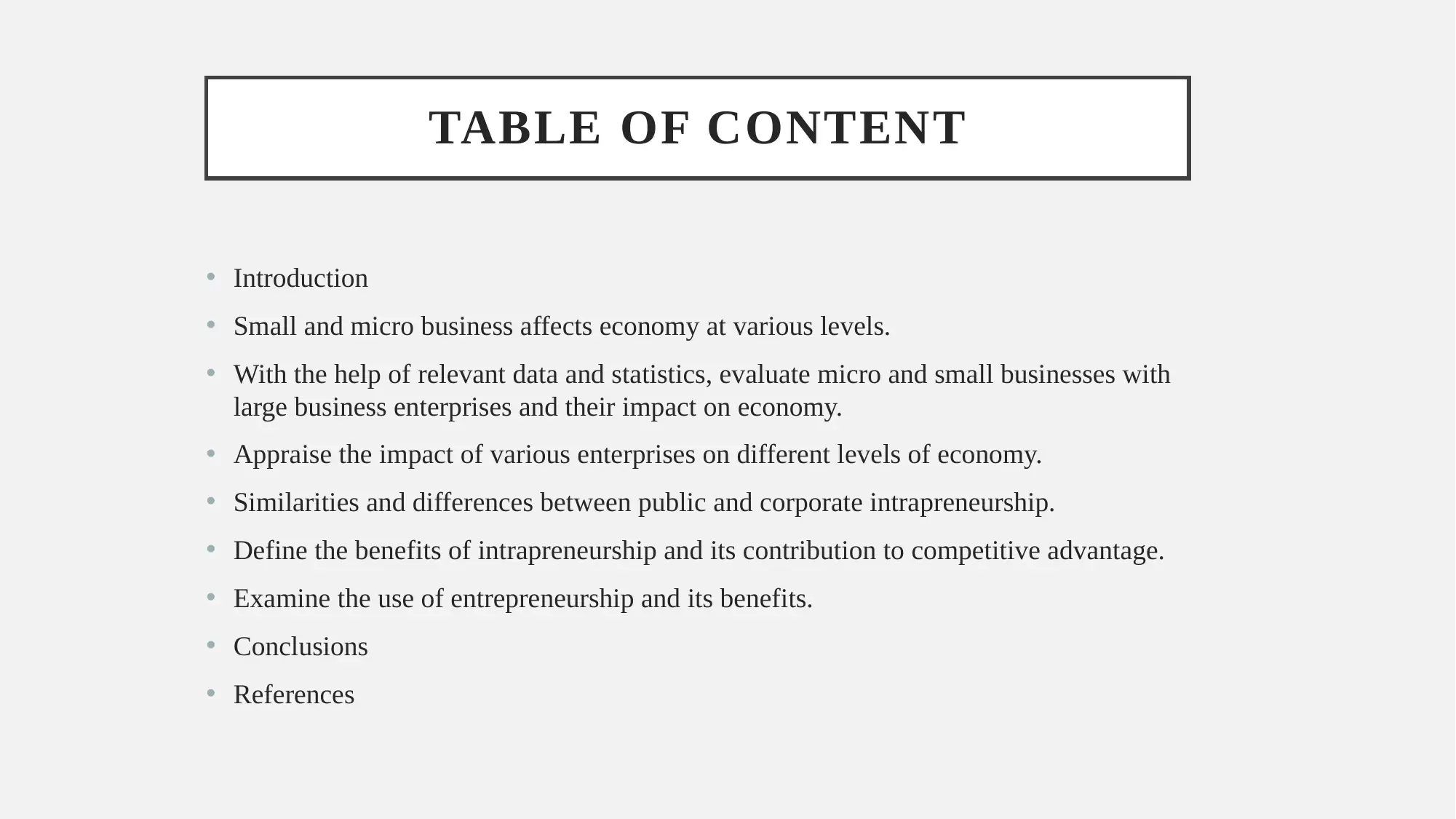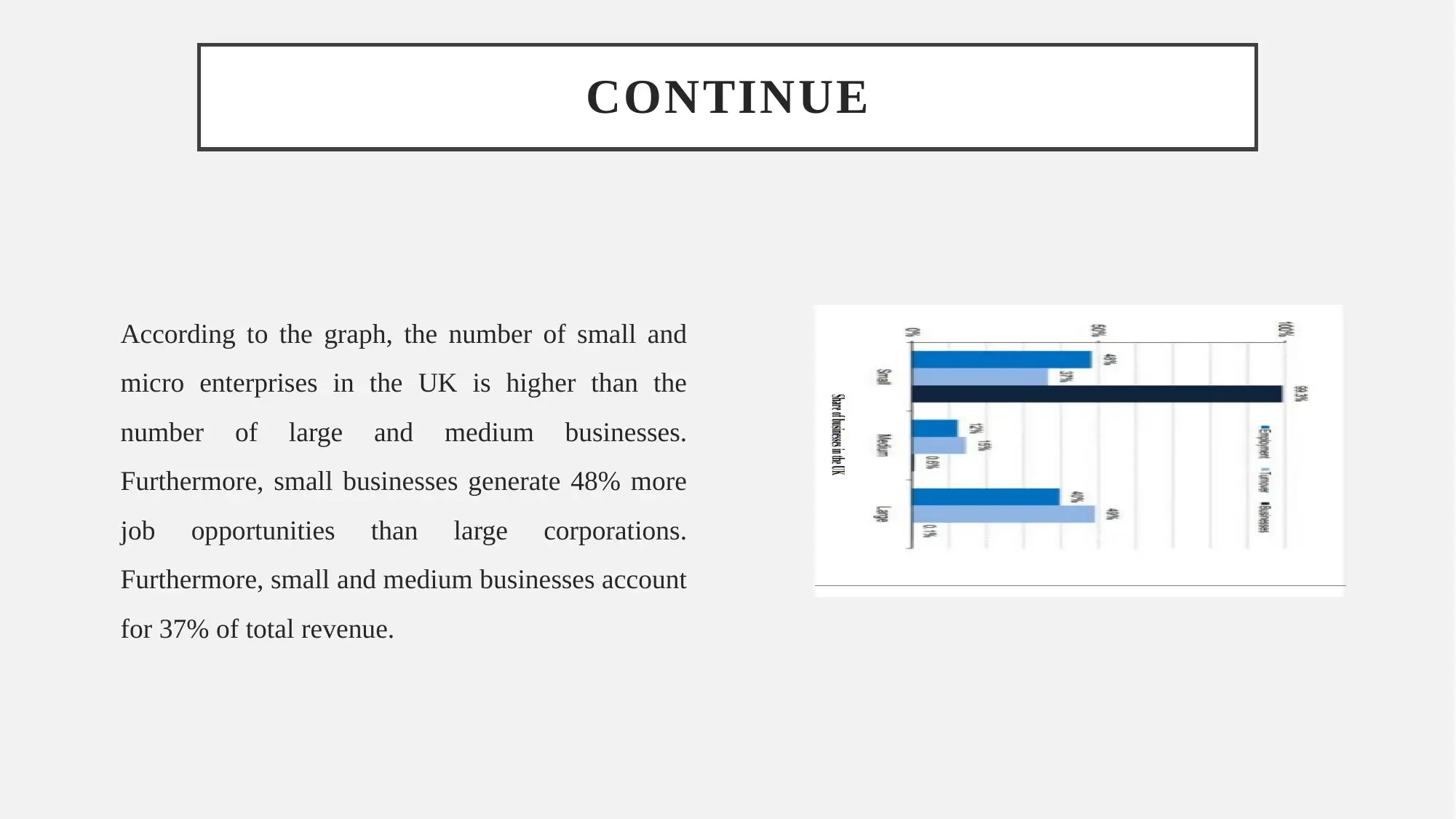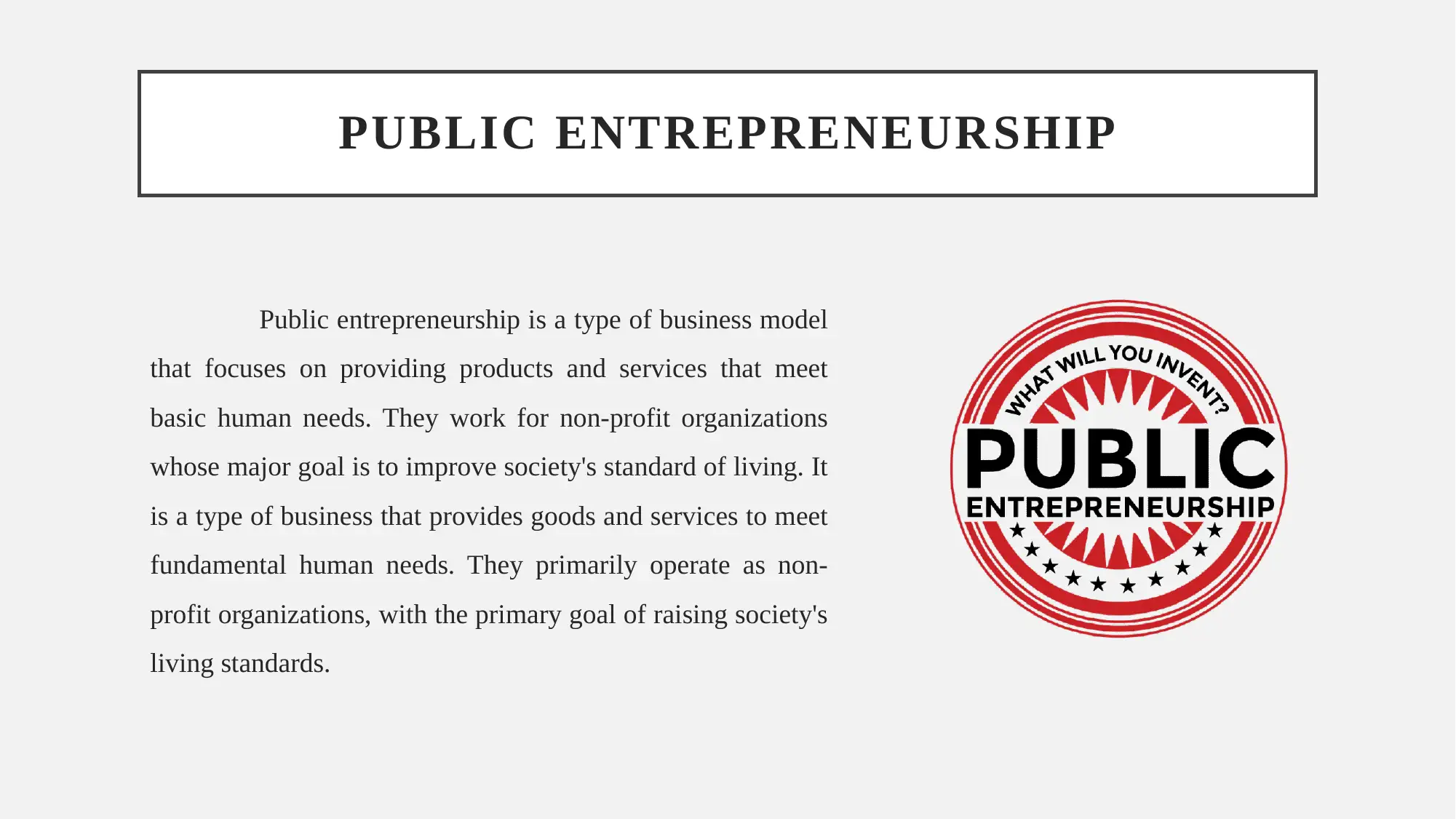Entrepreneurial Ventures: Micro, Small & Large Businesses on Economy
VerifiedAdded on 2023/06/10
|16
|1387
|382
Report
AI Summary
This report examines the impact of entrepreneurial ventures, focusing on the role of small and micro businesses in the economy. It evaluates the differences between these businesses and larger enterprises, assessing their contributions at local, national, and global levels. The report also explores the concepts of public and corporate intrapreneurship, highlighting their similarities and differences, and defines the benefits of intrapreneurship in achieving a competitive advantage. Furthermore, it examines the use of entrepreneurship and its benefits, concluding that small and medium-sized enterprises are critical to economic development through job creation, revenue generation, and foreign currency exchange.

ENTREPRENEURIAL VENTURES
Paraphrase This Document
Need a fresh take? Get an instant paraphrase of this document with our AI Paraphraser

TABLE OF CONTENT
• Introduction
• Small and micro business affects economy at various levels.
• With the help of relevant data and statistics, evaluate micro and small businesses with
large business enterprises and their impact on economy.
• Appraise the impact of various enterprises on different levels of economy.
• Similarities and differences between public and corporate intrapreneurship.
• Define the benefits of intrapreneurship and its contribution to competitive advantage.
• Examine the use of entrepreneurship and its benefits.
• Conclusions
• References
• Introduction
• Small and micro business affects economy at various levels.
• With the help of relevant data and statistics, evaluate micro and small businesses with
large business enterprises and their impact on economy.
• Appraise the impact of various enterprises on different levels of economy.
• Similarities and differences between public and corporate intrapreneurship.
• Define the benefits of intrapreneurship and its contribution to competitive advantage.
• Examine the use of entrepreneurship and its benefits.
• Conclusions
• References

INTRODUCTION
A small-scale enterprise is defined as a company with a
limited number of personnel, cash, and materials. It
might be a small business, a sole proprietorship, or a
partnership with fewer staff, funds, and other resources
than a larger corporation. This presentation
demonstrates how small and micro businesses have an
impact on the economy at various levels. Finally, the
similarities and contrasts between public and corporate
intrapreneurship will be discussed.
A small-scale enterprise is defined as a company with a
limited number of personnel, cash, and materials. It
might be a small business, a sole proprietorship, or a
partnership with fewer staff, funds, and other resources
than a larger corporation. This presentation
demonstrates how small and micro businesses have an
impact on the economy at various levels. Finally, the
similarities and contrasts between public and corporate
intrapreneurship will be discussed.
⊘ This is a preview!⊘
Do you want full access?
Subscribe today to unlock all pages.

Trusted by 1+ million students worldwide

SMALL AND MICRO BUSINESS AFFECTS
ECONOMY AT VARIOUS LEVELS
Every industry is seeing a surge in small and micro
businesses, which account for a significant share of
the economy while also contributing significantly to
it. The growing number of small and micro
enterprises contributes to higher income generation by
providing a variety of services and goods to
customers.
ECONOMY AT VARIOUS LEVELS
Every industry is seeing a surge in small and micro
businesses, which account for a significant share of
the economy while also contributing significantly to
it. The growing number of small and micro
enterprises contributes to higher income generation by
providing a variety of services and goods to
customers.
Paraphrase This Document
Need a fresh take? Get an instant paraphrase of this document with our AI Paraphraser

CONTINUE
According to the graph, the number of small and
micro enterprises in the UK is higher than the
number of large and medium businesses.
Furthermore, small businesses generate 48% more
job opportunities than large corporations.
Furthermore, small and medium businesses account
for 37% of total revenue.
According to the graph, the number of small and
micro enterprises in the UK is higher than the
number of large and medium businesses.
Furthermore, small businesses generate 48% more
job opportunities than large corporations.
Furthermore, small and medium businesses account
for 37% of total revenue.

CONTINUE
Small and micro businesses can be classified as
innovators, exporters, non-innovators, and non-
exporters. These businesses generate revenue
whether or not they innovate, and the majority of
the export goods receive foreign currency while
also contributing to the national economy.
•
Small and micro businesses can be classified as
innovators, exporters, non-innovators, and non-
exporters. These businesses generate revenue
whether or not they innovate, and the majority of
the export goods receive foreign currency while
also contributing to the national economy.
•
⊘ This is a preview!⊘
Do you want full access?
Subscribe today to unlock all pages.

Trusted by 1+ million students worldwide

WITH THE HELP OF RELEVANT DATA AND STATISTICS,
EVALUATE MICRO AND SMALL BUSINESSES WITH
LARGE BUSINESS ENTERPRISES AND THEIR IMPACT
ON ECONOMY
In comparison to larger organizations, there are
a considerable number of small and medium-sized firms
in the United Kingdom. These businesses have a major
presence in every area and industry, contributing
considerably to the national economy. Larger businesses,
on the other hand, produce significant amounts of money
just by providing high-quality goods and services, as well
as by leveraging their brand value.
EVALUATE MICRO AND SMALL BUSINESSES WITH
LARGE BUSINESS ENTERPRISES AND THEIR IMPACT
ON ECONOMY
In comparison to larger organizations, there are
a considerable number of small and medium-sized firms
in the United Kingdom. These businesses have a major
presence in every area and industry, contributing
considerably to the national economy. Larger businesses,
on the other hand, produce significant amounts of money
just by providing high-quality goods and services, as well
as by leveraging their brand value.
Paraphrase This Document
Need a fresh take? Get an instant paraphrase of this document with our AI Paraphraser

APPRAISE THE IMPACT OF VARIOUS ENTERPRISES
ON DIFFERENT LEVELS OF ECONOMY
Small and medium businesses have a variety of effects on the economy of the United Kingdom
at various levels. Small businesses can compete with similar businesses on a regional level by providing
high-quality goods and services that better meet the needs of their customers. Because of financial
constraints, those businesses are focusing on hiring workers with low incomes, and they also have limited
skill sets compared to others, which is advantageous and reduces unemployment. On a national level,
SMEs can expand into new areas while increasing revenue, allowing them to charge higher taxes to the
government. Most small businesses export their goods and services and open branches in different
countries on a global scale. This aids in the acquisition of foreign currencies, which contributes to the
nation's progress.
ON DIFFERENT LEVELS OF ECONOMY
Small and medium businesses have a variety of effects on the economy of the United Kingdom
at various levels. Small businesses can compete with similar businesses on a regional level by providing
high-quality goods and services that better meet the needs of their customers. Because of financial
constraints, those businesses are focusing on hiring workers with low incomes, and they also have limited
skill sets compared to others, which is advantageous and reduces unemployment. On a national level,
SMEs can expand into new areas while increasing revenue, allowing them to charge higher taxes to the
government. Most small businesses export their goods and services and open branches in different
countries on a global scale. This aids in the acquisition of foreign currencies, which contributes to the
nation's progress.

PUBLIC ENTREPRENEURSHIP
Public entrepreneurship is a type of business model
that focuses on providing products and services that meet
basic human needs. They work for non-profit organizations
whose major goal is to improve society's standard of living. It
is a type of business that provides goods and services to meet
fundamental human needs. They primarily operate as non-
profit organizations, with the primary goal of raising society's
living standards.
Public entrepreneurship is a type of business model
that focuses on providing products and services that meet
basic human needs. They work for non-profit organizations
whose major goal is to improve society's standard of living. It
is a type of business that provides goods and services to meet
fundamental human needs. They primarily operate as non-
profit organizations, with the primary goal of raising society's
living standards.
⊘ This is a preview!⊘
Do you want full access?
Subscribe today to unlock all pages.

Trusted by 1+ million students worldwide

CORPORATE ENTREPRENEURSHIP
It is a type of business that focuses on utilizing existing raw
materials, technology, and natural resources. Individual
productivity is the primary goal, as it aids in the expansion of
the economy. This is the type of entrepreneur that establishes a
company with the goal of leveraging existing raw materials,
natural resources, and innovations. The primary goal of a
corporate entrepreneur is to increase individual productivity,
which leads to increased economic growth.
It is a type of business that focuses on utilizing existing raw
materials, technology, and natural resources. Individual
productivity is the primary goal, as it aids in the expansion of
the economy. This is the type of entrepreneur that establishes a
company with the goal of leveraging existing raw materials,
natural resources, and innovations. The primary goal of a
corporate entrepreneur is to increase individual productivity,
which leads to increased economic growth.
Paraphrase This Document
Need a fresh take? Get an instant paraphrase of this document with our AI Paraphraser

SIMILARITIES
• The public and corporate types of entrepreneurship have their own set of goals and objectives.
• The public and corporate types of entrepreneurs have the capacity and power to inspire and
motivate their employees to work hard in order to achieve predefined goals.
• They also contribute to the implementation of their goals and strategies. Both are attempting to
benefit from the concept.
• The public and corporate types of entrepreneurs have the skills and abilities to seize further
business opportunities.
• They also identify challenges and complications in running and operating businesses, as well as
provide relevant solutions.
• The public and corporate types of entrepreneurship have their own set of goals and objectives.
• The public and corporate types of entrepreneurs have the capacity and power to inspire and
motivate their employees to work hard in order to achieve predefined goals.
• They also contribute to the implementation of their goals and strategies. Both are attempting to
benefit from the concept.
• The public and corporate types of entrepreneurs have the skills and abilities to seize further
business opportunities.
• They also identify challenges and complications in running and operating businesses, as well as
provide relevant solutions.

DIFFERENCES
The fundamental goal of a public entrepreneur is to bring about positive changes in society
to improve people's living standards by using skills and expertise to solve problems. They are the
ones who prioritized improving individual lives before making a profit for their company. The
effective adaptations and changes made by public entrepreneurs for the welfare of society can be
used to gauge their growth. While earned revenue in the firm can be used to assess a corporate
entrepreneur's performance and development, The main goal is to increase profitability for the
company by meeting client demand. Market share, net profit, brand position, and other indicators can
be evaluated to discover how a corporate entrepreneur evolves.
The fundamental goal of a public entrepreneur is to bring about positive changes in society
to improve people's living standards by using skills and expertise to solve problems. They are the
ones who prioritized improving individual lives before making a profit for their company. The
effective adaptations and changes made by public entrepreneurs for the welfare of society can be
used to gauge their growth. While earned revenue in the firm can be used to assess a corporate
entrepreneur's performance and development, The main goal is to increase profitability for the
company by meeting client demand. Market share, net profit, brand position, and other indicators can
be evaluated to discover how a corporate entrepreneur evolves.
⊘ This is a preview!⊘
Do you want full access?
Subscribe today to unlock all pages.

Trusted by 1+ million students worldwide
1 out of 16
Related Documents
Your All-in-One AI-Powered Toolkit for Academic Success.
+13062052269
info@desklib.com
Available 24*7 on WhatsApp / Email
![[object Object]](/_next/static/media/star-bottom.7253800d.svg)
Unlock your academic potential
Copyright © 2020–2025 A2Z Services. All Rights Reserved. Developed and managed by ZUCOL.




